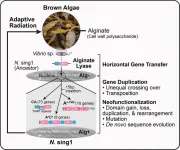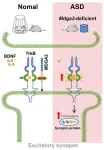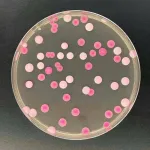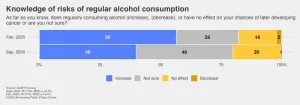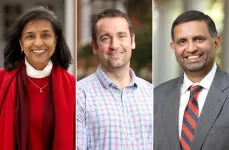(Press-News.org) A group of diatom species belonging to the Nitzschia genus, gave up on photosynthesis and now get their carbon straight from their environment, thanks to a bacterial gene picked up by an ancestor. Gregory Jedd of Temasek Life Sciences Laboratory, Singapore, and colleagues report these findings in a new study published April 1st in the open-access journal PLOS Biology.
Unlike most diatoms, which perform photosynthesis to generate carbon compounds, some members of the genus Nitzschia have no chlorophyll and instead consume carbohydrates from seaweed and decaying plant matter. Previously, it was unclear how exactly they made this major lifestyle transition, so researchers sequenced the genome of one species, Nitzschia sing1, to look for clues.
N. sing1’s genome sequence showed that the diatom carries a gene for an enzyme that breaks down alginate, a carbon polymer in the cell walls of brown algae – a group that includes kelp and other common seaweeds. The gene originally came from a marine bacterium, and an ancestor of N. sing1 took up the gene and incorporated it into its genome. Further analysis showed that, over time, the original gene was duplicated multiple times, with copies acquiring a variety of mutations that resulted in new functions. Those new functions have enabled N. sing1 to take up and break down alginate into carbon building blocks for the cell, so that photosynthesis is no longer necessary. This development also opened up a new ecological niche for this group of diatoms – living on seaweed in the intertidal zones.
While N. sing1 and many of its relatives can break down alginate, other non-photosynthetic Nitzschia species cannot, suggesting that these diatoms likely have other strategies for gaining carbon compounds. The researchers propose that sampling more Nitzschia species from the environment and sequencing their genomes will lead to a better understanding of how these diatoms source their carbon. Additional work in this area could also help us to learn more about how a single species diversifies into a range of new species and how carbon and other nutrients move through coastal habitats.
The authors add, “In this study we show how a non-photosynthetic diatom (diatoms are ancestrally photosynthetic microalgae) evolved the ability to metabolize the abundant brown algal cell wall polysaccharide alginate. This work not only identifies the evolutionary origins of a complex metabolic capability but also reveals the genetic mechanisms underlying the innovations that ultimately permitted these diatoms to occupy a new environmental niche as obligate heterotrophs.”
In your coverage, please use this URL to provide access to the freely available paper in PLOS Biology: https://plos.io/3EKbIf7
Citation: Lim ZH, Zheng P, Quek C, Nowrousian M, Aachmann FL, Jedd G (2025) Diatom heterotrophy on brown algal polysaccharides emerged through horizontal gene transfer, gene duplication, and neofunctionalization. PLoS Biol 23(3): e3003038. https://doi.org/10.1371/journal.pbio.3003038
Author countries: Singapore, Germany, Norway
Funding: This work was supported by Temasek Life Sciences Laboratory (G.J.), the Norwegian Research Council (Project no. 226244 (Norwegian NMR Platform), 294946 (SBP-N), and 315385 (AlgModE) to F.L.A.), and the German Research Foundation (DFG, NO407/7-2 to M.N.). The funders had no role in study design, data collection and analysis, decision to publish, or preparation of the manuscript.
END
A borrowed bacterial gene allowed some marine diatoms to live on a seaweed diet
One group of diatoms lost their chlorophyll and stopped photosynthesis to consume carbohydrates from seaweed instead
2025-04-01
ELSE PRESS RELEASES FROM THIS DATE:
Balance between two competing nerve proteins deters symptoms of autism in mice
2025-04-01
In mice, autism symptoms arise when a certain pair of competing nerve proteins falls out of equilibrium, according to a study published April 1st in the open-access journal PLOS Biology by Dongdong Zhao of Wenzhou Medical University, China, Yun-wu Zhang of Xiamen University, China, and colleagues.
Approximately 1% of the world population is considered to have Autism Spectrum Disorder (ASD), exhibiting a series of social and cognitive symptoms. Previous research has linked certain genetic factors to ASD, including many associated ...
Use of antifungals in agriculture may increase resistance in an infectious yeast
2025-04-01
Genomic changes in the infectious yeast Candida tropicalis may play a role in its resistance to antifungals, according to a study published on April 1st in the open-access journal, PLOS Biology by Guanghua Huang at Fudan University, China, and colleagues. These genomic changes can be brought on by a common antifungal, TBZ. The study demonstrates that the use of TBZ in agriculture may contribute to the increasing problem of antifungal resistance.
C. tropicalis is one of the most common fungi to infect humans, ...
Awareness grows of cancer risk from alcohol consumption, survey finds
2025-04-01
PHILADELPHIA – Public awareness of the link between drinking alcohol and an elevated risk of cancer has grown since last fall, with more than half of Americans now saying that regularly consuming alcohol increases your chances of later developing cancer, according to a survey by the Annenberg Public Policy Center (APPC) of the University of Pennsylvania.
In the survey, conducted Jan. 30-Feb. 10, 2025, with over 1,700 U.S. adults, 56% say the regular consumption of alcohol increases your chances of later developing cancer, up from 40% in an Annenberg survey in September 2024. The percentage of those who say alcohol ...
The experts that can outsmart optical illusions
2025-04-01
Medical imaging experts are adept at solving common optical illusions, according to research from four UK universities, including the University of East Anglia.
The correct analysis of medical images from scans, such as MRI, is critical for diagnosing cancer and many other conditions.
A new study published today shows that people who do this professionally are also more accurate at judging the size of objects in common optical illusions.
In other words, medical imaging experts also literally see better in everyday life!
The research is also the ...
Pregnancy may reduce long COVID risk
2025-04-01
Pregnancy may offer some protection from developing Long COVID, found a new study led by Weill Cornell Medicine, University of Rochester Medical Center, University of Utah Health and Louisiana Public Health Institute. Previous research has mostly focused on non-pregnant adults affected by Long COVID— a condition lasting for months after a person recovers from SARS-CoV-2 infection.
The study, published April 1 in Nature Communications, helps fill a critical gap about Long COVID in women infected with SARS-CoV-2 ...
Scientists uncover novel immune mechanism in wheat tandem kinase
2025-04-01
Wheat is grown over more land area than any other food crop. Among pathogen-driven threats to wheat, fungi top the list, causing billions of dollars of losses each year and posing a serious challenge to food security worldwide.
In an effort to combat this problem, a research team led by Prof. LIU Zhiyong from the Institute of Genetics and Developmental Biology of the Chinese Academy of Sciences, together with collaborators, has uncovered a novel immune mechanism by which tandem kinase proteins (TKPs) combat pathogen invasion in wheat.
TKPs are a recently discovered class of disease resistance proteins in wheat and barley. Characterized by two or more tandemly arranged ...
Three University of Virginia Engineering faculty elected as AAAS Fellows
2025-04-01
Faculty representing three disciplines in the University of Virginia School of Engineering and Applied Science — computer science, mechanical and aerospace engineering, and civil and environmental engineering — have been elected to the rank of fellow by the American Association for the Advancement of Science.
The AAAS is one of the world’s largest general scientific societies and publisher of the Science family of journals. UVA Engineering’s faculty are among 471 scientists and engineers named in the class of 2024, according to the AAAS.
Fellows are selected ...
Unintentional drug overdoses take a toll across the U.S. unequally, study finds
2025-04-01
A recent study from Columbia University’s Mailman School of Public Health reveals significant racial and sex disparities in drug overdose mortality rates. The research found that both Black men and Black women have been disproportionately impacted by overdose deaths, with their mortality rates rising sharply compared to their White counterparts. This study expands scientific understanding of how race, sex, and regional factors intersect to affect overdose outcomes. The study's findings are published ...
A step toward plant-based gelatin
2025-04-01
WASHINGTON, April 1, 2025 – With increased awareness about food sources and their environmental impacts, replacing animal-derived products in food and drugs is a significant research area. One common — but often overlooked — animal protein is gelatin, found everywhere from candy to plastic-free packaging.
In Physics of Fluids, by AIP Publishing, researchers from the University of Ottawa present gum tragacanth as a plant-based alternative to gelatin for creating edible films.
“Gelatin has ...
ECMWF unveils groundbreaking ML tool for enhanced fire prediction
2025-04-01
The ability to predict wildfires - such as those that recently devastated Los Angeles and Canada - is advancing rapidly with the help of ML–driven high-quality data. A new paper, published today (Tuesday 1 April, 16:00 BST | https://www.nature.com/articles/s41467-025-58097-7) in Nature Communications, highlights how the collection and integration of higher-quality data can significantly improve the accuracy and reliability of wildfire predictions.
The paper evaluates how ECMWF's new data-driven fire danger forecasting model, the Probability of Fire (PoF), performed in 2023 and in recent extreme events. ECMWF has been producing fire ...
LAST 30 PRESS RELEASES:
ASH 2025: AI uncovers how DNA architecture failures trigger blood cancer
ASH 2025: New study shows that patients can safely receive stem cell transplants from mismatched, unrelated donors
Protective regimen allows successful stem cell transplant even without close genetic match between donor and recipient
Continuous and fixed-duration treatments result in similar outcomes for CLL
Measurable residual disease shows strong potential as an early indicator of survival in patients with acute myeloid leukemia
Chemotherapy and radiation are comparable as pre-transplant conditioning for patients with b-acute lymphoblastic leukemia who have no measurable residual disease
Roughly one-third of families with children being treated for leukemia struggle to pay living expenses
Quality improvement project results in increased screening and treatment for iron deficiency in pregnancy
IV iron improves survival, increases hemoglobin in hospitalized patients with iron-deficiency anemia and an acute infection
Black patients with acute myeloid leukemia are younger at diagnosis and experience poorer survival outcomes than White patients
Emergency departments fall short on delivering timely treatment for sickle cell pain
Study shows no clear evidence of harm from hydroxyurea use during pregnancy
Long-term outlook is positive for most after hematopoietic cell transplant for sickle cell disease
Study offers real-world data on commercial implementation of gene therapies for sickle cell disease and beta thalassemia
Early results suggest exa-cel gene therapy works well in children
NTIDE: Disability employment holds steady after data hiatus
Social lives of viruses affect antiviral resistance
Dose of psilocybin, dash of rabies point to treatment for depression
Helping health care providers navigate social, political, and legal barriers to patient care
Barrow Neurological Institute, University of Calgary study urges “major change” to migraine treatment in Emergency Departments
Using smartphones to improve disaster search and rescue
Robust new photocatalyst paves the way for cleaner hydrogen peroxide production and greener chemical manufacturing
Ultrafast material captures toxic PFAS at record speed and capacity
Plant phenolic acids supercharge old antibiotics against multidrug resistant E. coli
UNC-Chapel Hill study shows AI can dramatically speed up digitizing natural history collections
OYE Therapeutics closes $5M convertible note round, advancing toward clinical development
Membrane ‘neighborhood’ helps transporter protein regulate cell signaling
Naval aviator turned NPS doctoral student earns national recognition for applied quantum research
Astronomers watch stars explode in real time through new images
Carbon-negative building material developed at Worcester Polytechnic Institute published in matter
[Press-News.org] A borrowed bacterial gene allowed some marine diatoms to live on a seaweed dietOne group of diatoms lost their chlorophyll and stopped photosynthesis to consume carbohydrates from seaweed instead
